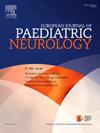儿童肿瘤性脱髓鞘病变
IF 2.3
3区 医学
Q3 CLINICAL NEUROLOGY
引用次数: 0
摘要
在t2加权脑MRI上,肿瘤病灶(TDL)直径大于2cm。它们与其他类型的脱髓鞘病变的区别在于其大小和病灶周围水肿和/或边缘增强的程度,这可能使诊断具有挑战性。目的探讨TDL患者的临床、影像学特征、随访及最终诊断。方法回顾1992年至2017年儿科神经病学和放射科儿童的医疗记录。15例年龄小于18岁的患者首次磁共振成像(MRI)时至少有一个TDL。并对其临床、放射学特征及影像学表现进行了研究。结果首先,所有患者均为急性多症状患者(86,6%),主要影响运动系统(92,8%)。最大的诊断组为多发性硬化症(n = 10, 66,6 %), 10例患者中有9例在随访期间确诊。12例患者中至少有一次新的临床或放射学复发,平均复发时间分别为9个月和14个月。所有放射学复发的病例和大多数(9.75%)临床复发的病例都被诊断为多发性硬化症,并且在诊断时都有新的病变。所有MS患儿ocb均呈阳性。大多数tdl(21/ 24,87,5 %)定位于幕上区。TDL +其他脱髓鞘病变占12/15 (80%),TDL大小在2 ~ 4cm之间(20/24,83.3%)。所有MS患者,无论是单发TDL还是多发TDL,均伴有小的脱髓鞘病变。随访时,所有tdl变小(14/ 15,93,3 %)或消退(n = 1)。结论非浸润型、多发小脱髓鞘病变及CSF寡克隆带阳性可能提示多发性硬化症,这是多发性硬化症最常见的病因之一。然而,为了明确诊断,即使在没有临床复发的情况下,患者也应继续接受放射影像学监测。本文章由计算机程序翻译,如有差异,请以英文原文为准。
Tumefactive demyelinating lesions in children
Tumefactive lesions (TDL) are larger than 2 cm in diameter on T2-weighted brain MRI. They are distinguished from other types of demyelinating lesions by their size and degree of perilesional edema and/or rim enhancement, which can make diagnosis challenging.
Aim
To study the clinical and radiological features, follow-up and final diagnosis of patients presenting with TDL.
Method
Medical records of children seen at the Pediatric neurology and radiology department between 1992 and 2017 were reviewed. 15 patients younger than 18 years of age who had at least one TDL on their first magnetic resonance imaging (MRI) were included. Clinical and radiological features and evolution of imaging findings were studied.
Results
First, all patients were admitted acutely with a polysymptomatic presentations (86,6 %) mainly affecting the motor system (92,8 %). The largest diagnostic group was MS (n = 10, 66,6 %) with 9 out of 10 individual's diagnosed during follow up. At least one new clinical or radiological relapse was observed in 12 patients with a mean occurrence of 9 and 14 months respectively. All cases who developed a radiological relapse and most (n: 9, 75 %) of those who experienced a clinical relapse were diagnosed with MS and all had new lesions at the time of diagnosis. All children with MS had positive OCBs. X children were diagnosed with xxxxx Most TDLs (21/24, 87,5 %) were localized in the supratentorial area. TDL + other demyelinating lesions were observed in most 12/15 (80 %) patients and the size of TDL was between 2 and 4 cm (20/24, 83.3 %). All patients with MS, whether they had a single TDL or multiple TDLs, had accompanying small demyelinating lesions. On follow-up all TDLs became smaller (14/15, 93,3 %) or resolved (n = 1).
Conclusion
The non-infiltratind pattern, presence of multiple small demyelinating lesions and CSF oligoclonal band positivity may suggest MS, which is one of the most common causes. However, for a definitive diagnosis, patients should continue to be monitored with radiological imaging even in the absence of clinical relapses.
求助全文
通过发布文献求助,成功后即可免费获取论文全文。
去求助
来源期刊
CiteScore
6.30
自引率
3.20%
发文量
115
审稿时长
81 days
期刊介绍:
The European Journal of Paediatric Neurology is the Official Journal of the European Paediatric Neurology Society, successor to the long-established European Federation of Child Neurology Societies.
Under the guidance of a prestigious International editorial board, this multi-disciplinary journal publishes exciting clinical and experimental research in this rapidly expanding field. High quality papers written by leading experts encompass all the major diseases including epilepsy, movement disorders, neuromuscular disorders, neurodegenerative disorders and intellectual disability.
Other exciting highlights include articles on brain imaging and neonatal neurology, and the publication of regularly updated tables relating to the main groups of disorders.

 求助内容:
求助内容: 应助结果提醒方式:
应助结果提醒方式:


